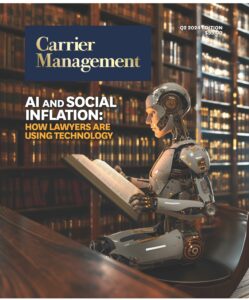Forty percent of U.S. workers believe that work is fundamentally broken, and 1 in 5 wish they didn’t have to work at all, according to Mercer’s 2024 Global Talent Trends Study.
Employees today feel that their productivity is being drained by too much busy work and not enough time to focus, said Kate Bravery, who leads Mercer’s Global Advisory Solutions & Insights practice, during a webinar discussing the study’s results. Employees also pointed to ineffective organizational structures, unsustainable workloads, and a desire for greater direction and feedback.
Bravery noted that 84 percent of U.S. employees feel at risk of burnout this year.
“If we’re going to make sure these people risks don’t translate into business risks, we’re going to have to solve for two challenges,” she said. “We need to increase the agility in our talent models so we can flex as demand and economic conditions shift, and we need to build more sustainable and inspiring people practices.”
Bravery said that Mercer’s theme for 2024 is building Workforce 2.0 and learning how to “effectively unlock human potential in a machine-augmented world.” She said research indicates that focusing in four areas will pay dividends:
- Driving human-centric productivity, intentionally redesigning work to redefine the productivity equation.
- Anchoring to trust and equity, recognizing that we can’t make progress on these transformation goals without a climate of fairness and trust.
- Boosting the corporate immune system, tackling some persistent risks and new risks that are coming in at both an enterprise and individual level.
- Cultivating a digital-first culture that will carry us through and usher in more adapted, fluid ways of working.
Human-Centric Redesign
“Everyone is being challenged this year to do more with less, to work faster, to deliver more cost-effectively,” Bravery said. “While we know that AI has the potential to be part of the solution, we also know that it’s humans that will effectively unlock AI’s real potential.”
To that end, 98 percent of organizations are planning work design changes so they can “truly get the best out of both humans and machine capability,” she said.
As part of the redesign, Mercer recommends embracing flexibility. While remote work isn’t always a viable option, companies can also consider potential variations in when the work happens, who does it, what they’re doing, how it gets done and why. Flexible working can help organizations strengthen the employee experience, diversify the workforce, tap into non-traditional talent pools and access new skills, the study notes.
Generative AI is expected to impact 80 percent of today’s jobs, according to Mercer’s research. Fifty-three percent of executives project that AI and automation will bring a 10-30 percent productivity boost to their organization over the next three years, and an additional 40 percent see an even greater upside.
But how are we going to spend those productivity gains? “Do we address the issues on the page, [such as] the stresses of the workforce, the inability to create time to learn?” Bravery wondered. “Do we invest in well-being, skilling, adjusted work weeks? Or do we directly flow these gains to the bottom line and essentially ask our workers to work harder?”
AI is changing workflows and transforming jobs by “putting a premium on specialist and more relational skill sets in humans,” Bravery said. “This means we need to upskill our workforce in tandem with this tech evolution so that they can lean into the more value-adding opportunities that will come their way.”
More than half of executives (51 percent) are planning to boost productivity this year by investing in upskilling/reskilling employees. Mercer pointed to the importance of talent intelligence, such as psychometric assessments (that measure employees’ work style, motivations and cognitive abilities) and technical skills audits (including self-report, proficiency scoring by managers and peers, and hackathons), which can help companies better match work to individuals’ skills and motivations.
Anchoring to Trust and Equity
Gordon Frost, leader of Global Rewards Solutions at Mercer, said that building a sense of trust in the workplace is very important this year—especially since employee trust has fallen from an all-time high in 2022.
He noted that there’s a lot of uncertainty in the world today, both “big global issues like economic uncertainty, political uncertainty, social unrest and international conflict, as well as the significant volume of change that people are experiencing in their own work lives.”
Because of all that uncertainty, building trust has become a key priority, he said. “If you don’t have clarity—because frankly, in a lot of cases you may not know what the future holds—then you need to have trust.”
“Trust is the currency of relationships,” Frost said. “High-trust relationships enable more difficult and more powerful conversations. People who have high trust in their workplace and who believe that their organizations will treat them fairly and equitably regardless of what the future may hold bring more energy to their work, and they feel a greater sense of fulfillment from the work that they do.”
Mercer’s research found that 69 percent of employees believe their employers will do the right thing for them, down from 80 percent during the pandemic. Only 34 percent believe that pay/promotion decisions at their company are made fairly, equitably and without bias.
Part of building trust is making sure that employees “feel fairly compensated for the time and effort they invest in their work,” Frost said. It’s not just about competitive salaries, he added. “They want to be treated fairly for the jobs that they do relative to the contributions that they make and their performance relative to their peers and relative to the external marketplace.”
“One of the challenges is that fairness can mean different things to different people,” he said. “So, you need to understand your employees’ perspective.”
Building a More Resilient Workforce
“You don’t have to look very far or wait for very long for a crisis these days; they’ve kind of become a fact of life. But if there is an antidote to crisis, it’s resilience,” said Beth Umland, Mercer’s director of Employee Research for Health and Benefits.
And it’s not just about enterprise resilience but the resilience of each member of the workforce, she added. “It’s about having the culture, the leadership and the response plans in place that can allow a company and its people to withstand crisis and constant change.”
Mercer’s research finds that resilient organizations are 1.8 times more likely to balance empathy and economics in decision-making. They also give equal priority to physical and psychological safety, ensuring that employees can voice their opinions freely without fear of repercussion and are able to bring their authentic selves to work.
Building a culture of resilience “requires taking care of your people all the time—not just during a crisis,” Umland said, noting that the pandemic has given employees greater expectations and “made all of us a bit more appreciative of the things in life that really matter, like our health and work-life balance.”
Companies today need to embrace “this new attitude and support it with the right mix of benefits and policies, because in the end a healthier, happier workforce is also going to be a more engaged and productive workforce,” she said.
Umland noted that it’s important to “listen to your employees to make sure that your investments in well-being are being made where they’re going to have the most impact.”
Cultivating a Digital-First Culture
“When we think about the concept of digital first [culture], one of the things that we oftentimes do in HR is we confuse digital with technology,” said Jason Averbook, global leader of Digital HR Strategy at Mercer.
“Digital is a mindset. Digital is a way of working. Digital is a way of being,” he said. “We use technology to enable that mindset.”
Still, two-thirds of organizations (67 percent) adopt new technology without transforming the way they work, according to Mercer’s research.
Cultivating a digital-first culture “doesn’t mean we’re replacing humans,” Averbrook said. “We’re amplifying humans.” It’s about “the value that humans can bring versus the value that technology can bring,” he said, noting that basic questions can be automated to “save the human for where it really matters.”
Averbrook said that cultivating a digital-first culture isn’t just about adding new technology; it’s about developing the right mindset and “changing how work works.”
Organizations need to have a “vision that ties back to the people strategy, which ties back to the organizational strategy,” he said. “We shouldn’t just do technology and we shouldn’t just be digital to be digital. We want to do it tied to what our drivers are.”
To create a digital-first culture it’s important to “think about work and break it down into hands work, heads work and hearts work,” Averbrook said. The aim of automation and digitization is to “eliminate the hands work.” We want to eliminate “work that’s repeatable, auditable and documented…so that we can shift our efforts toward the heads work and the hearts work,” he said. “Heads work and hearts work is what makes people stay…what drives engagement.”
***
 This article is featured in Carrier Management’s second-quarter 2024 magazine, “AI and Social Inflation.”
This article is featured in Carrier Management’s second-quarter 2024 magazine, “AI and Social Inflation.”
Related articles include:
- Avoid Employee Turnover by Asking 5 Simple Questions
- Put Motivation Back Into Performance Reviews
- ERM and Strategic Scenario Analysis: A New Way to Think About Innovation
All of the articles in the magazine are available on the magazine page of our website.
To be able to read and share individual articles more easily, consider becoming a Carrier Management member to unlock everything.





















 The Growth of a New Wave of Distribution Startups in Commercial Auto Insurance
The Growth of a New Wave of Distribution Startups in Commercial Auto Insurance  Rise of the Frequency Perils
Rise of the Frequency Perils  State Farm Wins Dismissal of Homeowners’ Class Action Over Use of Xactimate Software
State Farm Wins Dismissal of Homeowners’ Class Action Over Use of Xactimate Software  How Cincinnati Insurance Does E&S
How Cincinnati Insurance Does E&S 






